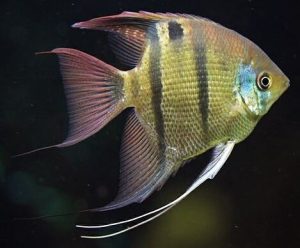Freshwater angelfish (scientific name Pterophyllum) are striking and popular fish commonly kept in home aquariums. They belong to the cichlid family and are native to slow-moving rivers and swamps in South America, particularly the Amazon Basin.
| Demographics | |
| Scientific Name | Pterophyllum |
| Origins | Amazon River (Amazon Basin) |
| Adult Size | 3″ to 4″ |
| Lifespan | 10 to 12 years |
| Temperment | Semi-Aggressive |
| Diet | Omnivore |
| Breeding | Egglayer |
| Min School Size | 2 |
| IUCN Status | LC |
| Tank Setup Parameters | |
| Temperature | 75°F to 82°F |
| pH | 6.8 – 7.2 |
| Water Hardness | Soft to Medium |
| Tank Zone | Top |
| Substrate | Sand / Fine Gravel |
| Heating Required | Yes |
| Lighting Requirement | Medium |
| Plant Friendly | Yes |
| Min Tank Size | 20 gallons |
Behaviour
Angelfish are generally peaceful, though they can become territorial, especially during breeding. They are considered semi-aggressive in community tanks. The species are social fish and do best in groups, but adult angelfish can establish a pecking order, with dominant individuals asserting their territory. Angelfish form monogamous pairs and are known for their parental care, as both parents guard the eggs and fry. They often lay their eggs on flat surfaces like leaves or tank glass.
PERSONAL NOTE
I have found that Angelfish are very social towards people. The Angelfish in my tanks always seem to be darting their eyes watching me. Maybe they think they are being fed every time I walk by, but they seem to be much more attentive than other fish species.
Tank Setup
Angelfish are tall and need ample space. A minimum tank size of 20 gallons is recommended for a pair. However, for groups or community setups, a 30-gallon tank is ideal. Angelfish appreciate taller tanks due to their body shape and long fins. They are a tropical species that will need water between 75 and 82 degrees with slightly acidic water. Angelfish do best in gentle water flow, using a sponge filter or a hang-on-back filter for filtration. Fine gravels or sand is a good substrate for Angelfish. To reduce stress, use live plants, rocks and driftwood to provide hiding places, but keep a good amount of swimming space.
Diet & Feeding
Angelfish are omnivores and need a varied diet. Feed them a combination of:
- flakes or pellets
- frozen or live foods like bloodworms, brine shrimp, and daphnia
- vegetables such as balanced spinach or zucchini.
Breeding
If you plan to breed your angelfish, provide broad-leaved plants or a spawning slate for them to lay their eggs. Angelfish are known to care for their eggs and fry, so minimal interference is required during this period.
Tank Mates
Angelfish do well with non-aggressive fish that won’t nip at their fins. The table at right summarizes most likely tank mates for the species.
Species Variations
Common Angelfish come in a lot of different colours and markings. They are also the most available at local fish stores. Some other species variations are:


Altum Angelfish (Pterophyllum altum)
This species is larger (10-13 inches) and rarer than the common variety. It is known for its tall body and distinctive, more pronounced “notch” between the head and the dorsal fin. Altum angelfish have a more vertical appearance and are often considered more delicate due to their specific water requirements.
Leopold’s Angelfish (Pterophyllum leopoldi)
This species is the smallest (up to 5 inches) and least common species in the aquarium trade. It is sometimes referred to as the “dwarf angelfish.” This species is more aggressive than the other two, and its body is less elongated. Typically silver with vertical black bars like the common angelfish, but its body is more compact, and the bars are often less pronounced. The dorsal and anal fins are shorter, and it lacks the “notch” between the head and dorsal fin that is seen in other varieties.

